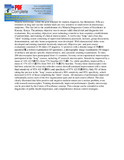| dc.description.abstract | Malaria microscopy, while the gold standard for malaria diagnosis, has limitations. Efficacy estimates in drug and vaccine malaria trials are very sensitive to small errors in microscopy endpoints. This fact led to the establishment of a Malaria Diagnostics Centre of Excellence in Kisumu, Kenya. The primary objective was to ensure valid clinical trial and diagnostic test evaluations. Key secondary objectives were technology transfer to host countries, establishment of partnerships, and training of clinical microscopists.
A twelve-day "long" and a four-day "short" training course consisting of supervised laboratory practicals, lectures, group discussions, demonstrations, and take home assignments were developed. Well characterized slides were developed and training materials iteratively improved. Objective pre- and post-course evaluations consisted of 30 slides (19 negative, 11 positive) with a density range of 50–660 parasites/μl, a written examination (65 questions), a photographic image examination (30 images of artifacts and species specific characteristics), and a parasite counting examination.
To date, 209 microscopists have participated from 11 countries. Seventy-seven experienced microscopists participated in the "long" courses, including 47 research microscopists. Sensitivity improved by a mean of 14% (CI 9–19%) from 77% baseline (CI 73–81 %), while specificity improved by a mean of 17% (CI 11–23%) from 76% (CI 70–82%) baseline. Twenty-three microscopists who had been selected for a four-day refresher course showed continued improvement with a mean final sensitivity of 95% (CI 91–98%) and specificity of 97% (CI 95–100%). Only 9% of those taking the pre-test in the "long" course achieved a 90% sensitivity and 95% specificity, which increased to 61% of those completing the "short" course. All measures of performance improved substantially across each of the five organization types and in each course offered.
The data clearly illustrated that false positive and negative malaria smears are a serious problem, even with research microscopists. Training dramatically improved performance. Quality microscopy can be provided by the Centre of Excellence concept. This concept can be extended to other diagnostics of public health importance, and comprehensive disease control strategies. | en |

